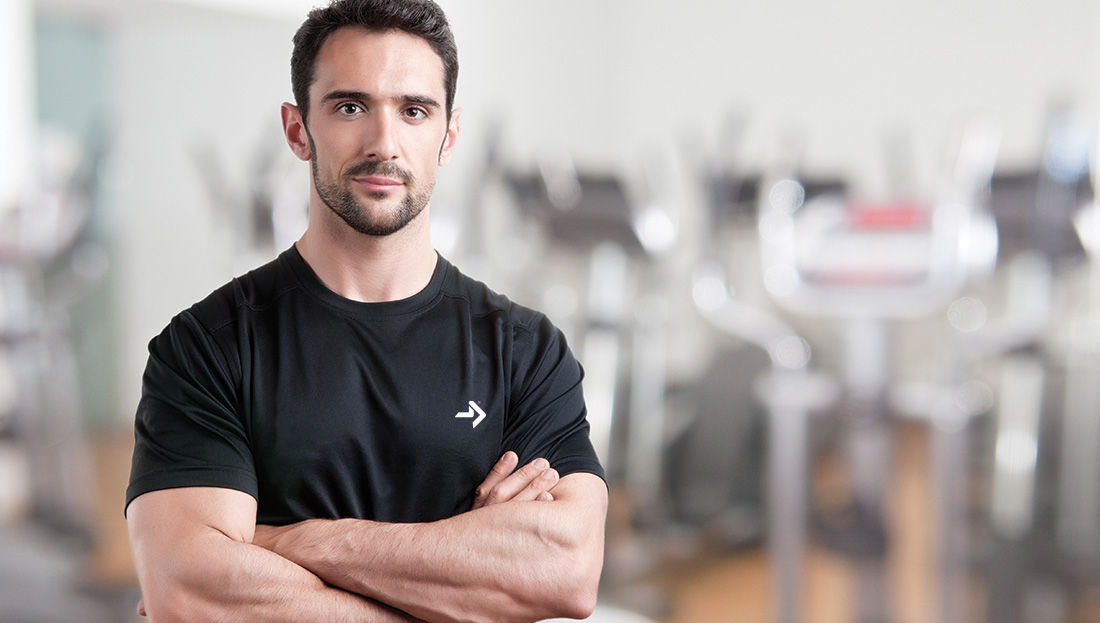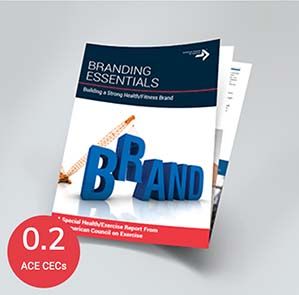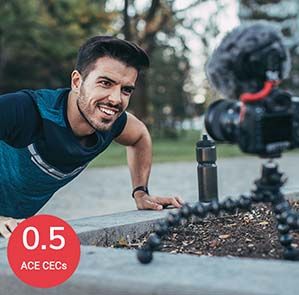
Hey, entrepreneur! Are you working on building your business? Or are you building your brand? What’s the difference? Is there one?
“Many will say they’re one and the same, but this couldn’t be further from the truth,” says Tara Ballard, owner of Prime Life Fit in Lewisville, N.C. “A business is comprised of your products and services; a brand is more about the image of your business, its identity.”
Here’s another way of looking at it: “Your business is the framework that houses your brand,” explains Billy Polson, CSCS, founder and co-owner of DIAKADI Fitness and The Business Movement in San Francisco, Calif. “In ‘house vs. home’ terms, if your business is the actual structure of your ‘house,’ your brand is the family and the good vibes that turn your house into a home.”
Polson explains that a business includes your structure and organization, as well as the basic products and services that you offer. “Your brand is a broader expression of your business and the energy that exudes from every single customer interaction. It includes the emotional impact you have on your community and world, how your business makes people feel and the connected way that you produce, market and distribute your products and services.”
As an example, Polson says that his personal trainer facility is defined as “a private workout facility that houses the practice of independent fitness and health practitioners,” and his brand is defined as “a heart-led community of advanced level fitness professionals that are committed to setting the bar in fitness education, facility design and connected customer experience for our family of clients, our community and our industry.”
Or as Entrepreneur magazine simply puts it: “Business is sales-focused, brand is community focused.”
Science Meets Art
While your brand is where you can allow your creativity to flow, there is also a science to creating the feeling you want to convey to customers and clients. For example, the findings of a Seton Hall University study on the value of color in brand strategy were congruent with previous research that showed that brands establish an identity, communicate a certain mood, and form relationships with customers and clients through their brand color choices.
“Deliberate colors, shapes and objects act as metaphors and symbolism,” explains Scott Fisk, artist, designer and owner of Studio 669 in Sharon, Vt.
For example, Fisk says that warm colors can convey an emotion of security. The types of fonts and shapes you use also matter. Certain fonts “feel” more stable and convey authority and certainty, while others are lighter and less “serious” or, perhaps, more approachable. And others are somewhere in between.
Even the shadowing of the letters in your logo or marketing materials can spark a certain emotion. “The shadow that typically rolls to the right of the letters [can be] cast in reverse, creating [a feeling of] ‘onward momentum,’” says Fisk. “[Keep in mind that] a brand is more than just designing and getting words out the door. No matter your line of work, relationships and trust matter.”
And building those relationships and trust can start with a simple color palette.
Is One More Important Than the Other?
Let’s say you already have a business in place. Do you have to also build a brand? “Can you run a business without a brand? Most definitely,” says Polson. “But adding a brand-level experience to your business gives it a heart and soul and makes it a heck of a lot more fun!”
Both potential and current clients need something to connect to. Your personality is that “something” and is a big part of your brand.
“People will buy your products and services because they know, like and trust you,” explains Ballard. “And you are your brand.”
To create a clearer picture, Polson lays it out like this: “On a basic business level, every advanced level personal trainer should include the following items in their business offerings:
- A comprehensive fitness and health assessment
- Individualized programming and tracking
- Coaching for technique and form
- Reassessments and program adjustments to guarantee results
“As a brand, a personal trainer has limitless options for creative ways to develop and establish their brand, including:
- The deeper mission and purpose behind ‘the why’ of products and services
- The voice, personality, vibe and connected nature of their marketing materials and business presentation
- The Ubuntu (i.e., compassion and humanity) philosophy and the positive connection and contribution a business makes to their clients, their community and our world
- Beyond the physical products and actual services, the additional events and programs sponsored or organized by the business community.”
Your products and services are part of your business and are equally as important as your brand. “An amazing brand is nothing without a high-quality product or service to back it up,” states Polson. “Thoroughly research your competitive market and your target clients’ goals and pain points in order to offer truly unique products and services that [position you] as the leader in your market and are the best fit for your clients’ needs.”
Once you have your products and services, the branding elevates them. “When you consider the leading brands in the service industry, none of them rely on simply being a good product,” adds Polson. “Every single one of the leading service industry products are wrapped inside an even more amazing experience. Your service industry fitness business can never reach its full potential without a strong commitment to establishing a powerful, unforgettable brand.”
The Basics of Brand Building
While some of this may seem overwhelming, there’s a good chance you’re already in the process of building your brand—it’s just a matter of being more intentional about it.
Ballard says there are three things to consider when building your brand, the first being your values and what’s important to you. “What do you stand for?” she asks. “For me, it is integrity, health, family, freedom and honesty. If you’re not clear on these, then it will be hard to go [much further].”
Once you nail down your values, you need to figure out who you’re serving and create your client avatar. “Who is your ideal customer or client? Give them a name and get really detailed about them,” states Ballard. “These are the people you would want to be attracted to your offering.”
Finally, says Ballard, be consistent in your messaging. “Stay true to your values and to your avatar. Add ridiculous value to your target market.”
Providing amazing client experiences is one way to add “ridiculous value.” “Rise above the baseline level standards of your competitors and peers,” recommends Polson. “Constantly look outside of the fitness industry to add unexpected, ‘11 star’ level customer experiences to your marketing, intake process, client integration and retention practices. Your goal is to have your customers doing your marketing for you by talking about you at dinner parties and on their Zoom calls for work.”
When you know who you’re serving (have you created a client avatar?), you know what problems you need to help them solve—and what products and services will provide them with the solutions they need. Polson suggests taking your clients’ needs and comparing them to what your competitors are currently offering your clientele. Use this information to create products and services that are unique and perfectly matched to your clients’ needs.
Finally, says Polson, be committed to constantly setting the bar higher. “When it comes to branding and staying out front, your work is never done,” he says. “With every one of my fitness business clients, we work through an annual vision exercise of how they are going to improve their products, services and customer experience in the year ahead. Never rest on your laurels and constantly be on the lookout for ways to up your game and stay far ahead of everyone else in your competitive market.”
Business and branding go hand-in-hand. When building your own brand, think about the factors that draw you to other brands. While the product or service may be what initially gets your attention, what makes you a repeat customer? This is where branding comes in—it’s what gives your business a personality. And it’s what will make it stand out from others in the same field.
Do You Need a Logo?
A logo is a part of your branding, and like anything else, designing an effective logo involves some science. Researchers at Harvard University compared logos from 597 different companies to determine whether descriptive versus nondescriptive logos were more beneficial. They concluded that “more (vs. less) descriptive logos can positively influence brand evaluations, purchase intentions, and brand performance.” But why bother with a logo to begin with? According to the study’s authors, “A well-designed logo…can help pique the interest of consumers, differentiate brands from competitors, facilitate brand recognition, influence investors’ decisions, and convey what a brand is all about.”
Expand Your Knowledge
 |
With countless options in the marketplace for consumers, it can be difficult for fitness “solo-preneurs” to set themselves apart from the big corporate brands. This course will help you learn how to build a strong brand identity that can guide your social media and traditional marketing efforts so you can take the pressure off having to sell your services.
|
 |
With social media, wearable tech and on-demand fitness continuing to innovate the health and fitness industry, it’s important that you embrace digital to remain relevant and stay connected with clients. The Transforming Your Digital Business Strategy course bundle offers the strategies you need to grow your business online and use fitness technology trends to your advantage.
|
 |
This course covers the knowledge and tools you need to make the leap from exercise professional to fitness leader and business owner. Led by Stephen Tharrett, renowned fitness business consultant and prolific author on the subject, this course is designed to help you master the competencies necessary for running a profitable fitness studio, full-service club or non-profit facility.
|





 by
by 





